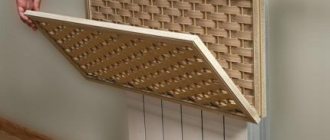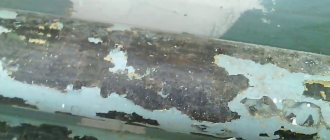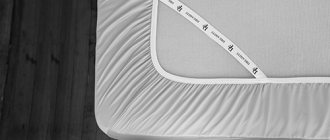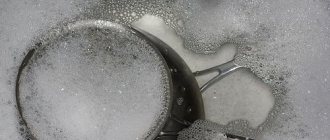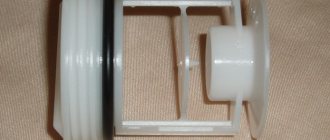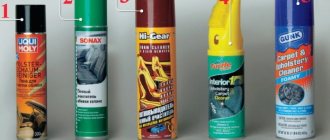How to disassemble a cast iron radiator
The joints of the old battery are quite strong. In many cases, they “grow together” in such a way that strength alone is not enough. Therefore, before disassembling the battery, it should be placed on boards and properly prepared.
The simplest preparation involves heating the joint. To do this, use a hair dryer or a blowtorch. The latter can burn old paint. However, it's not scary.
More serious preparation involves heating the metal to such an extent that it begins to glow. After this they try to unscrew the nipple. This can be done both when the alloy becomes very hot, and when it has cooled noticeably. The second option is even better, because during cooling the gasket becomes covered with cracks and the strength of the connection becomes weak. He is often shown in videos.
To disassemble a battery made of cast iron, you need to perform the following steps:
- Unscrew the plugs (plugs).
- Place the radiator key on top of the device so that the flattened end rests on the nipple. Make a mark on the key where the battery ends using chalk or electrical tape.
- Insert the key inside the bottom hole.
- Turning it along the axis to the right and left, insert it into the product up to the drawn mark.
- Determine which way the nipple is screwed. To do this, bait it with the right and left sides. If you manage to bait it with the right side, then you need to unscrew it counterclockwise.
- If you manage to move the nipple, then make one revolution. Next, a similar procedure is done with the nipple at the other end of the section.
- Both nipple nuts are unscrewed in turn. Otherwise the section will crack.
- In the same way, you need to unscrew all sections.
If it was not possible to disassemble the heating battery in this way, you will have to saw through the section that is leaking. At the same time, they saw it in the center of the nipple. The work is carried out by picking up a grinder or a hacksaw.
Another option is to break the bad section with a sledgehammer. You need to break the middle part of the section. The nipple, which remains unharmed, is unscrewed using a plumbing wrench. It can also be knocked out using a hammer and chisel. Then you need to clean the threads in entire sections.
Tools for disassembling a cast iron device
Their list consists of:
- Radiator key.
- Chisels.
- Hammer.
- A small sledgehammer.
- Brushes with metal bristles.
- Blowtorch.
- Plumbing wrench No. 2,3. They need to unscrew the side plugs or plugs.
In many cases there is no radiator key. The situation is complicated by the fact that it is almost impossible to find in construction stores. Of course, it exists in the markets. Also, plumbers must have such a key.
The key itself is a round metal bar. which is 18 mm in diameter. One end is flattened and resembles a spatula. It has dimensions 28x40 mm. Thickness 6 mm. At the other end there is a welded ring. You need to insert a lever into it. As for the length of the key, it should exceed half the length of the radiator by 30 cm.
You also need to prepare several boards. Chocks may be suitable instead. They will be fitted with a battery before disassembly.
Battery cleaning brushes and sponges
To remove old stains, the following will help:
- A toothbrush, brush or narrow paint brush with stiff bristles. They are able to crawl into the most remote corners of the radiator.
- Sponge. If you attach it to a long ruler, it can also clean hard-to-reach places.
- Rubber glove. You need to put it on your hand and wash it well with laundry soap. Then rub off stubborn stains on the heater using your fingers. Can be replaced with old cut-off tights or socks.
- Dishwashing brush. Use this brush to clean the battery. They are sold in hardware stores and have a comfortable long handle.
- Spray. In order to wash the inside of old batteries, you need to add detergent to the spray bottle and spray the dirt. Wait a while and wipe the soaked areas with a damp cloth.
Methods
Today, several methods are known for flushing heating systems. They are different, so it is advisable to choose them taking into account the degree of clogging of the radiators, the volume of the circuits, and the length of the blockage.
You can implement washing in the following way:
- mechanical;
- chemical;
- dispersed;
- hydrodynamic;
- hydropneumatic;
- electrohydropulse.
It is worth considering that each method has its own nuances that increase its effectiveness. For example, flushing the system with pressurized water alone is ineffective, because you can’t even expect pressure if the circuit is almost completely clogged with compressed scale and rust.
Mechanical
For such cleaning, the pipes are disassembled. It effectively removes accumulated dirt, but is weakly effective against scale on the internal surfaces of the circuit. Before such flushing, close the valves before and after the boiler, then drain the water from the circuit using a drain valve. If it is not there, unscrew the cap on the radiator, which is located lower and farthest in the apartment. For greater efficiency, after draining the water, the batteries are dismantled.
To disassemble the radiator, use wrenches of the required size, including pipe wrenches. To do this, loosen the union nuts that connect the radiator to the pipes. The radiator is taken outside or into the bathtub, first covering it with thick textiles that protect it from mechanical damage. After washing, the textiles are discarded. The drain in the bathtub is covered with a mesh to prevent clogging of the sewer.
They clean the radiator with a cable and use it to clean the pipes. You can remove the primary dirt into a previously prepared container to reduce the load on the sewage system. For greater efficiency, before flushing, you can disassemble the radiator into sections of 2-3. After cleaning, the battery is washed by directing a stream of water into the internal circuit. To do this, use a hose with an adapter, ensuring the tightness of the hose connection. Stop washing when the outlet water becomes clear.
Chemical
This method is one of the most effective in private and apartment buildings. To carry it out, chemical reagents are used. The method is accessible to everyone, as it is cheap, simple and has quick results. To wash the batteries this way, it is not at all necessary to stop the heating system. In addition, you can flush the radiator in this way not only in winter, but also in summer. The method is effective against calcium salts and rust.
Handy cleaning products
The means at hand will help you get to the most remote nooks and crannies between the battery sections.
- Sprayer or country sprayer. Place a rag or a small container under the heating radiator to prevent the liquid from dripping onto the floor. Dissolve a few drops of dishwashing detergent in water and spray onto dirt. Leave to soak. Then use a sponge or rag to wash off the softened plaque.
- Window painting brushes with long handles and curled bristles and pipe cleaners. Or wrap a thin strip or ruler at least 15 cm long with a cloth soaked in a cleaning solution.
- Toothbrushes are suitable for cleaning heavy stains.
- You can remove accumulated grease on kitchen cast iron radiators using boiling water. Place a small tray and cover the finishing materials around with film or a rag. Pour hot water from the kettle over the battery from top to bottom. The dust along with it falls into the pan, which we drain into a bucket brought in advance. After treating with boiling water, simply wipe the radiator with a dry cloth.
- You can water the battery from top to bottom and from a hose connected to a hot water tap. But in this case, it is better to place a larger container under the battery, and have a bucket with good capacity nearby. When working with boiling water, you need to be extremely careful so as not to scald your feet or burn your hands. For convenience, you can work in special mittens or use oven mitts.
- The foam sponge can be cut in half so that there is a hole inside, and a ruler or any wide strip can be inserted into the resulting cut.
A sponge for washing the battery with a bendable ruler for convenience.
During the non-heating season or in case of replacing risers around the house, you can remove the battery and place it in a container filled with water and detergent. Give it time to soak, and then use a stream of water to wash off all the accumulated dirt during the period of use. If a bathtub is used as a container, it should be covered with thick terry towels so as not to damage the enamel.
Centralized cleaning or individual
Residents of apartment buildings can clean the heating system individually and centrally. Utilities provide such services using primarily hydropneumatic technology. But for this, the procedure must be agreed upon with the neighbors, and certain material costs will also be required. Centralized flushing may take some time. For owners of private houses, only individual cleaning is possible.
Types
Before cleaning the heating system, you first need to determine the metal of the batteries.
Aluminum radiators cannot be cleaned in the same way as copper-brass and cast iron ones. This is due to the fact that the former do not use solder in their construction and this metal reacts negatively to caustic soda.
Aluminum is a more reactive metal than copper-brass and can be dissolved with caustic soda. Because of this, these radiators undergo a different cleaning process.
As long as the coolant is replaced and flushed regularly, aluminum radiators do not require flushing.
Copper-brass and cast-iron radiators can be cleaned using any available methods.
When is the best time to clean?
Here the opinions of experts differ. Many people advise flushing batteries at the end of the heating season, that is, from May to September. There is no need to turn off anything, and the water will not interfere with the process. Many, on the contrary, say that flushing should be carried out while heating the premises, having first turned off and drained the water. Then, at the end of the process, the functionality of the radiators will be immediately visible. And everyone will be able to determine whether they are fully heated after cleaning.
It is advisable to carry out general cleaning once every three years, even if there is no apparent reason for this. This way you will prolong the operation of your entire heating system.
Do-it-yourself washing
In order to rinse heating radiators (aluminum and cast iron) yourself, without involving dangerous chemicals and complex devices, the radiators will have to be dismantled.
Sequencing:
- Preparing tools and space. For the procedure you will need the following tools: a set of keys, paint, sealing tow, a large container. During dismantling, the contents of the batteries will most likely spill, so you need to cover the floor with plastic film and additionally lay a rag on it. It is also necessary to move nearby furniture, remove curtains and, if possible, cover the walls. In an apartment, the bathroom will be used, so you should take care of the covering and tiles. In the bath itself, you should put a wooden tray and a mesh over the drain into the sewer.
- Dismantling. When removing the radiator, turn off the coolant supply tap or drain the water from the system. Next, unscrew the radiator and drain the remaining water into a prepared container. Now the battery can be moved to the bathroom.
- Flushing. For convenience, you should unscrew the plugs and shut-off valves. Next, we pass a stream of hot water under pressure through the radiator. If there is a lot of dirt and water does not help, you can use a solution of soda ash, vinegar, citric acid, car radiator cleaners or other available acid-base compounds. To do this, you need to return the plugs to their place and pour in the cleaning solution for a couple of hours. While the reagent is active, it is recommended to tap the radiator to enhance the reaction. Then rinse thoroughly with water and repeat the procedure if necessary.
- Return to place. It is necessary to wipe the radiator, seal the plugs with tow and paint. Learn how to install heating batteries in an apartment yourself using the link.
What products should I use for cleaning?
You can use different products for cleaning. For example, chemistry is very effective, that is, specialized detergents sold in stores, designed for cleaning various surfaces and containing surface-active particles that literally dissolve contaminants.
Folk remedies are also effective, and sometimes they deal with dirt faster than store-bought ones. A few proven recipes:
- Soap solution. Moreover, it is best to use laundry soap to prepare it, since it contains alkali, and it quickly removes dirt. Grate a piece and dissolve in a small amount of hot water.
- Lemon juice or citric acid. Simply squeeze a lemon or dissolve two teaspoons of powder in half a glass of warm water.
- Vinegar. You can use essence; it will definitely cope with even complex stains. But you need to work with it carefully, wearing thick rubber gloves.
- Baking soda is also an effective detergent that has been proven for generations. You need to prepare either a solution by adding a couple of teaspoons to half a glass of hot water, or a slurry by diluting the powder with a small amount of water. The composition is applied to the surfaces and to achieve the best effect, it is left on them for 15-30 minutes, depending on the degree of contamination.
- Hydrogen peroxide can also be used to clean radiators. Just use a cotton swab to apply it to contaminated surfaces and leave, then vigorously rub them with a rag and remove the product along with the dirt.
Cleaning batteries using special equipment
Cleaning cast iron batteries without removing them can be done using special equipment. The following complex equipment is intended for domestic needs:
- pneumatic pistol "Typhoon";
- device for electrohydropulse influence ZEVS-24;
- cleaning device Krot-Mini.
Pneumatic pistol "Typhoon"
Air pistol "Typhoon"
Flushing the battery with a Typhoon pneumatic gun
The equipment is compact and easy to use. It is used to perform targeted impact on blockages in water and sewer pipes with a diameter of up to 150 mm. The essence of the process is a hydraulic ram to remove hardened deposits from the walls of equipment and adjacent risers with a shock wave at a speed of 1.5 km/h, which spreads over a distance of up to 60 meters.
Pneumatic pistol "Typhoon" in action
This cleaning of the heating system allows you to completely remove contaminants that are not amenable to conventional hydraulic flushing.
"Typhoon" is indispensable as a plumber's tool for clearing blockages in various hard-to-reach places. Depending on the configuration and weight, the device has 6 modifications and the following indicators:
- internal cleaning diameter up to 150 mm;
- maximum firing range to the target is 60 m;
- special valve design for kinetic ramming;
- pressure gauge on the body;
- Possibility of manual inflation.
Comprehensive flushing of heating batteries
As a rule, “Typhoon” is used in conjunction with the ZEVS-24 automatic installation and the Krot-Mini device for cleaning hard-to-reach objects.
Installation ZEUS-24
ZEUS-24 has small dimensions and sufficient power to destroy hardened heating devices, internal and external water supply and sewerage networks that are firmly stuck to the inner walls. The essence of its work is based on the electrohydropulse effect on solid contaminants in pipes with a diameter of 7 to 150 mm. The electrical discharge created by the device leads to the generation of a shock wave and powerful hydrodynamic flows that act on hardened clogs, scale and deposits.
Procedure for hydropneumatic flushing of heating radiators (batteries)
Advantages of the device:
- destruction of blockages of any strength;
- safety of the equipment being cleaned;
- cleaning of hard-to-reach bent and spiral pipes;
- wear resistance of manufacturing materials;
- protective shutdown on the plug.
Krot-Mini device
The unit is used for cleaning pipes with a diameter of 20 to 150 mm. It is compact, has sufficient power, is affordable and is indispensable for cleaning in-house sewer networks and other pipelines. The design is easy to use; the spiral in the drum makes it possible to clean any hard-to-reach places. The device is intended for a wide range of consumers: from homeowners to housing and communal services, hotels, gas stations, and industrial enterprises.
Chemical and traditional methods
To increase cleaning efficiency, detergents can be added to the water. Before use, you must make sure that the composition does not contain substances contraindicated for treating specific surfaces. Some substances can damage the metal surface. We should not forget about the harmfulness of some components to the human body, for example, phosphate and chlorine. When working with such substances, it is important to use respiratory and skin protection.
Hydrogen peroxide
A good helper in the household is 3% hydrogen peroxide. This well-known substance perfectly cleans and disinfects batteries. To use, add ¾ of a bottle to 2-3 liters of water. To remove severe stains, you can use pure peroxide by applying the substance directly to the stained area or with a sponge.
Lemon acid
Using citric acid, you can not only effectively clean the radiator from contamination, but also get rid of the unpleasant odor. As a rule, the smell appears from stagnant water and flower fertilizer that has reached the surface of the radiator. To prepare a cleaning solution, you will need to dissolve 3 tsp in a glass of water. citric acid.
Baking soda
Regular baking soda is suitable for cleaning the battery. To do this, dissolve 2 tbsp in 3 liters of water. l. soda For greater effect, you can add 1 tsp. apple cider vinegar and 7 drops of any liquid soap.
Vinegar 9%
Vinegar is poured into a spray bottle for further spraying onto the stained area, previously cleaned with a damp cloth. Afterwards, the battery must be thoroughly rinsed with water and wiped. Vinegar essence mixed with water in a ratio of 1:10 can also be used. When spraying in the room, the windows should be open; it is better to protect the respiratory tract with a mask.
Use of special compounds
Effortlessly, in just a few minutes, special cleaning products will help remove dirt and grease stains. To remove greasy stains, you can use dishwashing detergents, for example, Fairy, Pemolux, MYTH. Before use, it is necessary to dilute the concentrate in water, foam it and wipe the surfaces of the radiator with a brush or sponge. Light stains can be removed with laundry soap. Complex contaminants can be removed using special household chemicals intended for plumbing fixtures and household appliances, for example, Domestos, Krot, Tiret. Old stains are removed using stain removers, for example, “Vanish” and “Antipyatin”.
Signs of contamination of a cast iron battery
Since after the end of the heating season the water is drained from the system, and it remains dry all summer, this causes the formation of corrosion even in the most resistant metal. For many years, small rust formations do not cause harm to the heating network and its elements, but over time, the layers of rust become thicker, changing the quality and efficiency of radiators.
You can notice that cast iron batteries require flushing based on several signs:
- If during the heating season it is discovered that one of the sections or the entire radiator is colder than the rest of the devices, then this is a clear sign that the channels in it are littered or narrowed by a coating of rust.
- When the temperature of the riser exceeds the heating of the battery, this is another sign that the hot water is not entering it in full.
- If the radiators throughout the apartment are slightly warm, you should not immediately scold the “careless” heating network workers. You need to find out from your neighbors how hot their batteries are. If their apartment is warm, then you should think about how to wash cast-iron radiators in the operating conditions of the heating network.
- Another clear sign of a blockage may be uneven heating of the battery. If this is not an air lock, which is easy to check by opening the Mayevsky tap, then it means scale or debris.
- It happens that in one radiator one section is colder than the other. This means that the channel in this place is clogged. Since flushing cast iron radiators in individual sections is impossible, the entire structure will have to be dismantled.
These are the main signs that your batteries need cleaning. In order not to take matters to such extremes, it is better to carry out preventive flushing of heaters, although sometimes you can entrust this process to heating network workers before the start of a new heating season.
how to clean the battery
Moderator: na-din
how to clean the battery
Post by Bubu » Mon Oct 02, 2006 12:28 pm
The day before yesterday, a professional cleaner taught me how to quickly and easily clean a cast iron radiator. we will need a kettle of boiling water, a baking tray, a dust cloth and a rag and a bucket for the floor. the baking sheet is placed under the battery, and boiling water is poured over the battery from top to bottom. all the dust is washed off into a baking tray, and dirty water from there into a bucket. We wipe the battery from residues and the floor from splashes. We admire the result.
I've been admiring it for 2 days now
Post by Anasty » Mon Oct 02, 2006 4:28 pm
By mistake, many people believe that an accordion battery is a cast-iron sectional radiator. In fact, everything is not like that. This is a heat exchanger made of steel pipes bent in a zigzag, on which plates are put on, increasing the heat exchange area. The fins are covered with a casing, which is often replaced with a screen. Those who have experienced the operation of these radiators know how difficult it is to wash an accordion battery. Everything has to be done manually.
Washing with soda ash and whey
According to videos filmed by various experts, cleaning with soda ash is carried out as follows:
- Plugs (plugs) are placed on the two holes of the outer section.
- Soda ash is diluted in hot water. Half a standard pack for 6-10 liters is enough.
- They lift the heating radiator from the floor, placing it on the section with plugs. The section with two free holes should be at the top.
- Water with soda ash is poured through one hole. Air will escape through the other. Therefore, it does not need to be drowned out.
- Plug both holes and place the battery on the floor. The heating device must lie down.
- So that the soda ash can eat away any adhering dirt, rust, and possibly even old paint that has come in with the water, the radiator needs to be shaken. To do this, grab the top and raise/lower it several times. The bottom should not come off the floor. The same is repeated on the other side.
- Relax for 1 hour, watching a video on the Internet about the features of removing old paint from cast iron and applying new paint.
- Lightly tap along the entire perimeter with a wooden hammer. This is done so that the dirt is completely removed from the walls. At this time, the paint may come off. This means that it was poorly attached to the cast iron.
- Place the radiator on the nightstand so that one of the plugs is in the air.
- Place a bucket under the plug and unscrew the plug.
- After draining the water, the radiator should be flushed. To do this, unscrew the plug at the opposite end and insert the hose from the water supply. Open the tap. Water will flow into the radiator under pressure, thanks to which it will be possible to wash away dirt and completely clean the heating device.
To clean the radiator with serum, you need to follow all the steps described above. Just use whey instead of soda. This process, of course, can be seen in various videos.
